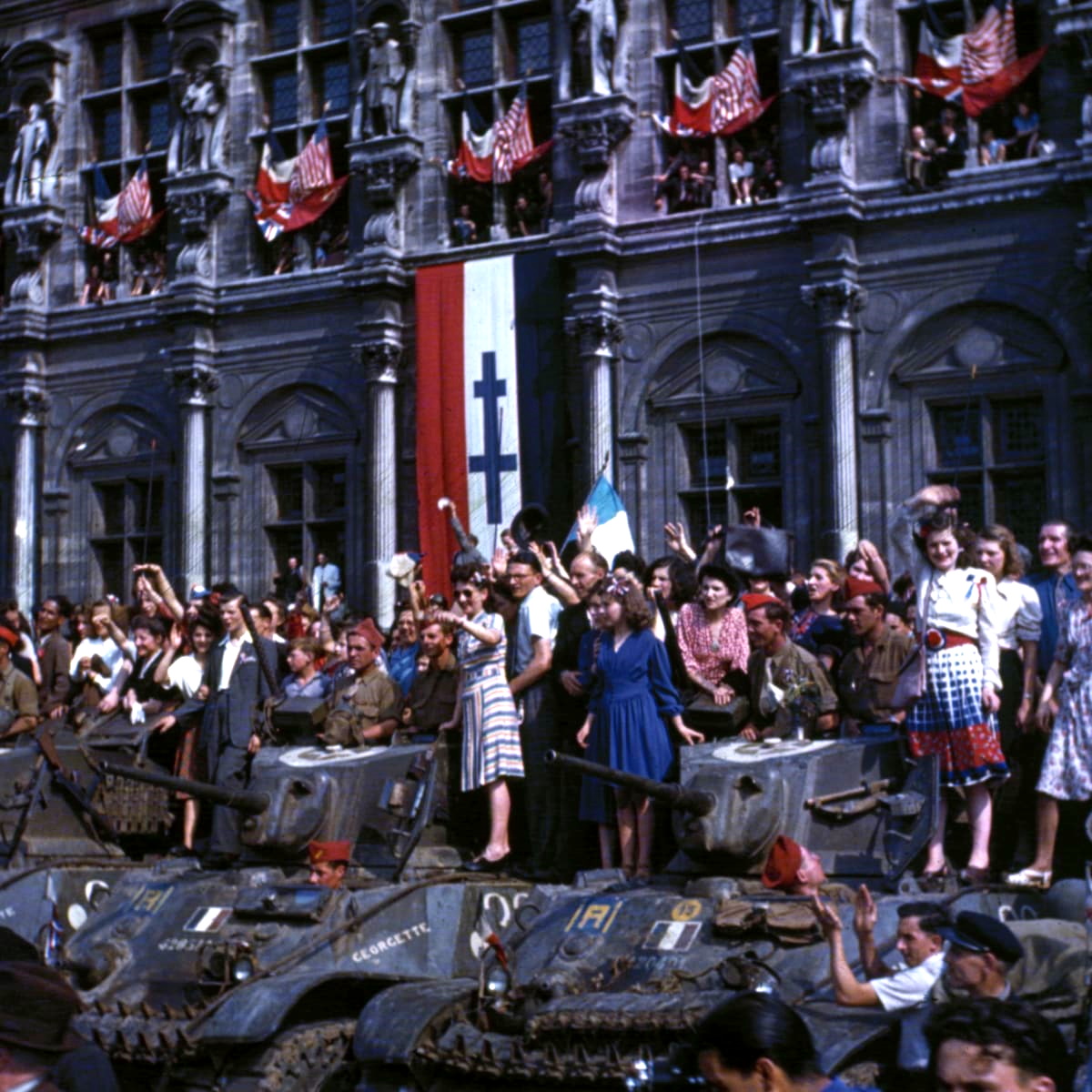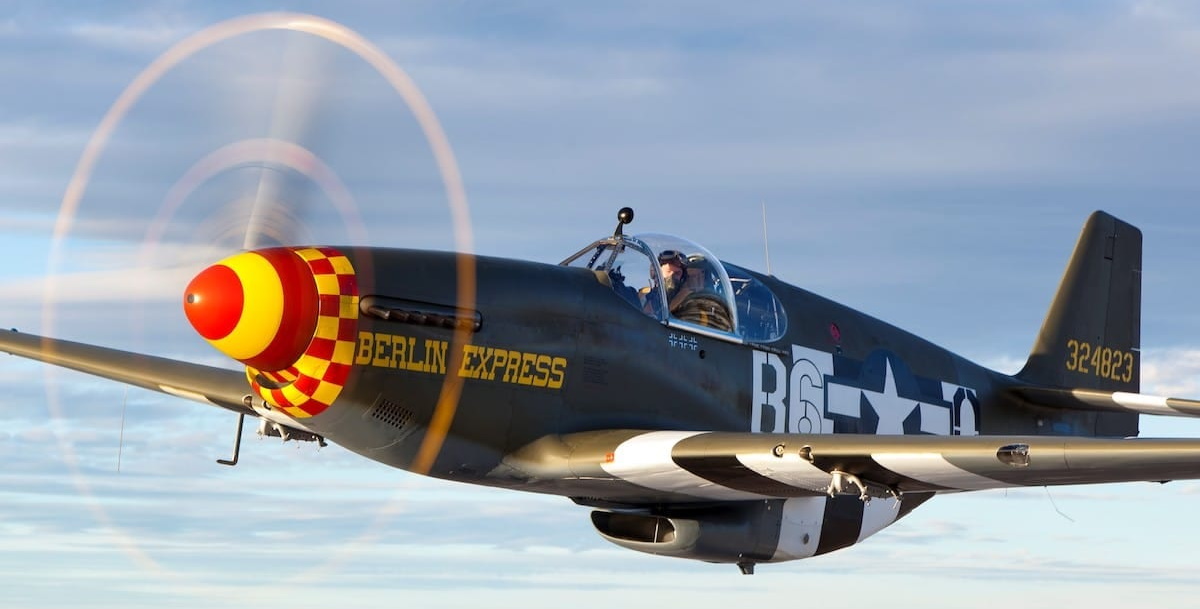 This was another busy day with 659 combat sorties and 40 tactical recon and artillery adjustment sorties flown. On the ground, the haul included 5 locomotives, 114 railroad cars, 36 armored vehicles, 97 motor vehicles, and 5 barges destroyed or damaged. 9 gun positions, 4 airfields, and 1 marshaling yard were successfully attacked. An advance echelon of this Command had leap-frogged forward to a woods north of Laval, and during the early morning hours, the 3-A and the XIX TAG headquarters there were strafed by P-47s. One was shot down by the antiaircraft fire and the pilot’s body was identified as that of an 8-AAF fighter pilot.
This was another busy day with 659 combat sorties and 40 tactical recon and artillery adjustment sorties flown. On the ground, the haul included 5 locomotives, 114 railroad cars, 36 armored vehicles, 97 motor vehicles, and 5 barges destroyed or damaged. 9 gun positions, 4 airfields, and 1 marshaling yard were successfully attacked. An advance echelon of this Command had leap-frogged forward to a woods north of Laval, and during the early morning hours, the 3-A and the XIX TAG headquarters there were strafed by P-47s. One was shot down by the antiaircraft fire and the pilot’s body was identified as that of an 8-AAF fighter pilot.
After several days of intensive operations, activity was curtailed on Aug 16 by low stratus clouds which covered airfields in the Cherbourg Peninsula from approximately 1000 to 1500. Many pilots returning from early morning missions were unable to land at their own airfields. One P-51 crashed near St Mère Eglise when it ran out of gas, but the pilot bailed out successfully. Fourteen other pilots of the 363rd Group were forced to land in England, where they refueled and returned to base after the weather cleared. The 3-A’s foremost armored spearhead now was only 9 miles from the outskirts of Paris, and the enemy’s air was reacting more strongly in the effort to gain time for evacuation of the great complex of airfields in the capital area. Preferring to attack only when they outnumber us, the enemy’s fighters were operating usually in patrols ranging from 20 to 80. Our P-51 cover-west and southwest of Paris has strengthened accordingly.
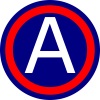
 The weather during the day favored the enemy, since our bases were socked in for several hours while his were clear. Hourly attacks by three strafing Me-109s were reported by CCA-4-AD at Orléans.
The weather during the day favored the enemy, since our bases were socked in for several hours while his were clear. Hourly attacks by three strafing Me-109s were reported by CCA-4-AD at Orléans.
These strafers successfully eluded our fighters, but a probable attack on our ground forces southwest of Paris was apparently prevented at 1545 when  70 plus Fw-190s, many carrying bombs, were engaged by 8 P-51s of 354th Group over the Rambouillet Forest, 10 miles west of the capital. Two German planes were shot down and two P-51s were lost, but the enemy force was dispersed toward the south.
70 plus Fw-190s, many carrying bombs, were engaged by 8 P-51s of 354th Group over the Rambouillet Forest, 10 miles west of the capital. Two German planes were shot down and two P-51s were lost, but the enemy force was dispersed toward the south.
Half an hour later, another patrol of eight P-51s sighted 20 plus Me-109s south of Dreux at 11000 feet. Orbiting in elements of two, the squadron climbed to 14000 feet and attacked from above. At the same instant, 60 or more Me-109s joined the combat, emerging from cloud cover to the north. In the next 15 minutes, our 8 aircraft outnumbered 10 to 1 were busily embattled from 11000 feet to deck. The enemy was aggressive and apparently experienced, but he tried to turn with our aircraft. When it was all over, our pilots had destroyed 11 and damaged 2 against losses of 2 planes and pilots.

 One of the 14 enemy aircraft destroyed during the day was shot down near Paris by a P-51 from the tactical recon pilot of the 10th Recon Group. This P-51s, operating in pairs, carry the regular fighter armament and are amply able to defend themselves, as they frequently prove to the enemy when bounced by several times their number.
One of the 14 enemy aircraft destroyed during the day was shot down near Paris by a P-51 from the tactical recon pilot of the 10th Recon Group. This P-51s, operating in pairs, carry the regular fighter armament and are amply able to defend themselves, as they frequently prove to the enemy when bounced by several times their number.
 Flying close cover for the 7-AD and the 5-ID between Dreux and Paris 8 P-51s of the 362nd Group sighted 50 or more Me-109s on an airfield just southeast of the capital. Field, planes, MT, personnel, and a gun position were promptly strafed. At another airfield west of Paris, 20 or more Fw-190s were seen, and on a third, farther east, two Ju-88s and a hangar were seen afire. At Etampes–Mondésir airfield, the 513th Squadron of the 406th Group scored hits on hangars with its rocket projectiles.
Flying close cover for the 7-AD and the 5-ID between Dreux and Paris 8 P-51s of the 362nd Group sighted 50 or more Me-109s on an airfield just southeast of the capital. Field, planes, MT, personnel, and a gun position were promptly strafed. At another airfield west of Paris, 20 or more Fw-190s were seen, and on a third, farther east, two Ju-88s and a hangar were seen afire. At Etampes–Mondésir airfield, the 513th Squadron of the 406th Group scored hits on hangars with its rocket projectiles.
 Heavily outnumbered and decidedly outfought by the Allied Air Forces ever since the invasion, the Luftwaffe was
Heavily outnumbered and decidedly outfought by the Allied Air Forces ever since the invasion, the Luftwaffe was being forced to make excuses to the Army for its inability to provide proper support. An example was a document found at the Headquarters for southwest France at Angers, in the 3-A, and translated by the Air PW Interrogation Unit of 9-AAF. It was issued by the Military Governor in France for dissemination to troops down to company level and said in part the ground soldier in action on the invasion front feels depressed most of all by enemy air superiority. In spite of the numerical inferiority of our air force, there have been successes accomplished, however, which the single soldier, tied down to his own narrow section of the front, cannot appreciate. The following AAF information should be made known to the troops so that they may know what great support the fighting forces are receiving from their own air force.”
being forced to make excuses to the Army for its inability to provide proper support. An example was a document found at the Headquarters for southwest France at Angers, in the 3-A, and translated by the Air PW Interrogation Unit of 9-AAF. It was issued by the Military Governor in France for dissemination to troops down to company level and said in part the ground soldier in action on the invasion front feels depressed most of all by enemy air superiority. In spite of the numerical inferiority of our air force, there have been successes accomplished, however, which the single soldier, tied down to his own narrow section of the front, cannot appreciate. The following AAF information should be made known to the troops so that they may know what great support the fighting forces are receiving from their own air force.”
(There followed figures emphasizing alleged German air successes against Allied shipping from June 6/25, 1944.) With the cutting of a number of rail lines leading to Paris from the east, considerable barge traffic on the Seine River from Moret north through Melun and Corbeil to Villeneuve was noted by the A-2 Section.
It was pointed out that these barges were believed to transport quantities of motor fuel toward the battle area. In subsequent days this barge traffic was successfully attacked by our fighter-bombers.
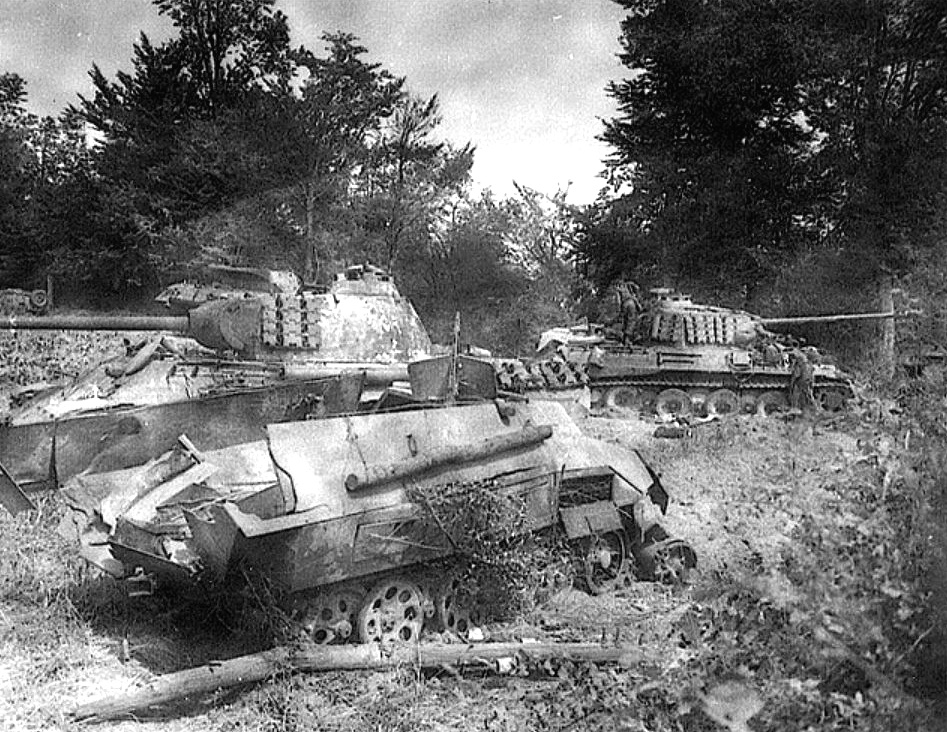 Because of the weather, only 280 combat sorties and 36 recon sorties were flown on Aug 16. Thirteen enemy planes were destroyed and 4 damaged. 5 of ours were lost. 5 tanks, 25 motor vehicles, and 55 railroad cars were destroyed or damaged, 2 airfields and 2 gun positions attacked, and 3 railroad lines cut.
Because of the weather, only 280 combat sorties and 36 recon sorties were flown on Aug 16. Thirteen enemy planes were destroyed and 4 damaged. 5 of ours were lost. 5 tanks, 25 motor vehicles, and 55 railroad cars were destroyed or damaged, 2 airfields and 2 gun positions attacked, and 3 railroad lines cut.
AUGUST 17-1944
 In sharp contrast to the previous day, air opposition to our fighters on Aug 17, was virtually nil, despite the fact that the enemy’s fields in the Paris area and east of the capital had good weather while ours were cloud-covered part of the day. The only reported enemy activity against our ground forces was the strafing of 79-ID units near Dreux. One of the strangers was shot down by AAA. This attack occurred in the morning when our fields were closed in and enemy fields near Paris were clear only 2 enemy planes were seen by our fighters, and both were shot down near Dreux by the same pilot, Capt Emerson, of the 355th SSquadron of the 354th Group.
In sharp contrast to the previous day, air opposition to our fighters on Aug 17, was virtually nil, despite the fact that the enemy’s fields in the Paris area and east of the capital had good weather while ours were cloud-covered part of the day. The only reported enemy activity against our ground forces was the strafing of 79-ID units near Dreux. One of the strangers was shot down by AAA. This attack occurred in the morning when our fields were closed in and enemy fields near Paris were clear only 2 enemy planes were seen by our fighters, and both were shot down near Dreux by the same pilot, Capt Emerson, of the 355th SSquadron of the 354th Group.
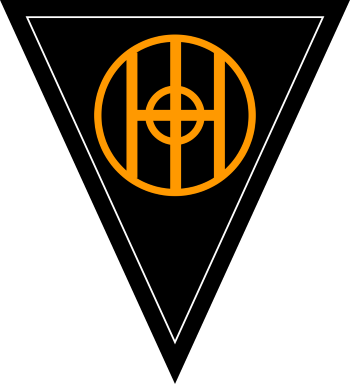 On the Brest Peninsula, the citadel of St Malo surrendered, while the 3-A troops and circling P-47s of 53rd Squadron (36th Group), loaded with 500-GP bombs, awaited the answer to an ultimatum. After 35 minutes the 83-ID radioed the squadron that the invitation had been accepted. A white flag appeared over the citadel and the P-47s came home with their 500-PGP persuaders. Incidentally, 83-ID reported that
On the Brest Peninsula, the citadel of St Malo surrendered, while the 3-A troops and circling P-47s of 53rd Squadron (36th Group), loaded with 500-GP bombs, awaited the answer to an ultimatum. After 35 minutes the 83-ID radioed the squadron that the invitation had been accepted. A white flag appeared over the citadel and the P-47s came home with their 500-PGP persuaders. Incidentally, 83-ID reported that  prisoners captured in the St Malo area since the attack began totaled 11.600. The clean-up of the Germans attempting to escape from the Argentan pocket was now in full swing and there were many good targets, but Allied aircraft were so numerous that they had to queue up to attack. For instance, 8 P-47s of the 373rd Group spotted 100 or more tanks and 200 plus MT 10 miles southwest of Lisieux. The target was already being bombed and strafed by 4 P-51s and 8 Typhoons, and 50 or more fires were burning. The P-47s dumped their two 500-PGP bombs and 24 frags into the mess and saw a tank destroyed, but the smoke was so thick no other results could be seen.
prisoners captured in the St Malo area since the attack began totaled 11.600. The clean-up of the Germans attempting to escape from the Argentan pocket was now in full swing and there were many good targets, but Allied aircraft were so numerous that they had to queue up to attack. For instance, 8 P-47s of the 373rd Group spotted 100 or more tanks and 200 plus MT 10 miles southwest of Lisieux. The target was already being bombed and strafed by 4 P-51s and 8 Typhoons, and 50 or more fires were burning. The P-47s dumped their two 500-PGP bombs and 24 frags into the mess and saw a tank destroyed, but the smoke was so thick no other results could be seen.
Dreux, 50 miles from the center of Paris, had fallen and armored units were driving ahead toward the Seine. North of Dreux, 8 P-47s flying armored column cover were vectored by 5-AD to a road junction where anti-tank guns and infantry were holding  up the advance. The ground forces marked the target with white smoke and our Thunderbolts attacked it with 6 500-PGP bombs, 4 frag clusters, and strafing. Results were not observed, but the ground forces indicated the guns were destroyed and congratulated the squadron leader.
up the advance. The ground forces marked the target with white smoke and our Thunderbolts attacked it with 6 500-PGP bombs, 4 frag clusters, and strafing. Results were not observed, but the ground forces indicated the guns were destroyed and congratulated the squadron leader.
The day in figures gives 331 combat sorties, 56 recon sorties; 2 enemy planes destroyed in combat, no losses; 10 tanks, 57 motor vehicles, 2 locomotives, and 25 railroad cars destroyed or damaged; 7 railroad lines cut; 4 gun positions, a strong point, and 4 marshaling yards attacked. As the eastward advance continued, the 3-A reported Chateaudun clear of the enemy. Immediate steps were taken to make this good airfield available to our groups, which already were laboring under heavy handicaps of range. Because of the speed of our advance in this area, the Germans had not had the opportunity to carry out demolitions as extensively as in most other fields.
A pre-war military and civil airfield, Chateaudun had been much developed by the German Luftwaffe, which built the runways and dispersal areas and later extended the landing area to the west. Repairs were expedited, and by Aug 27, the field was occupied by our 10th Recon 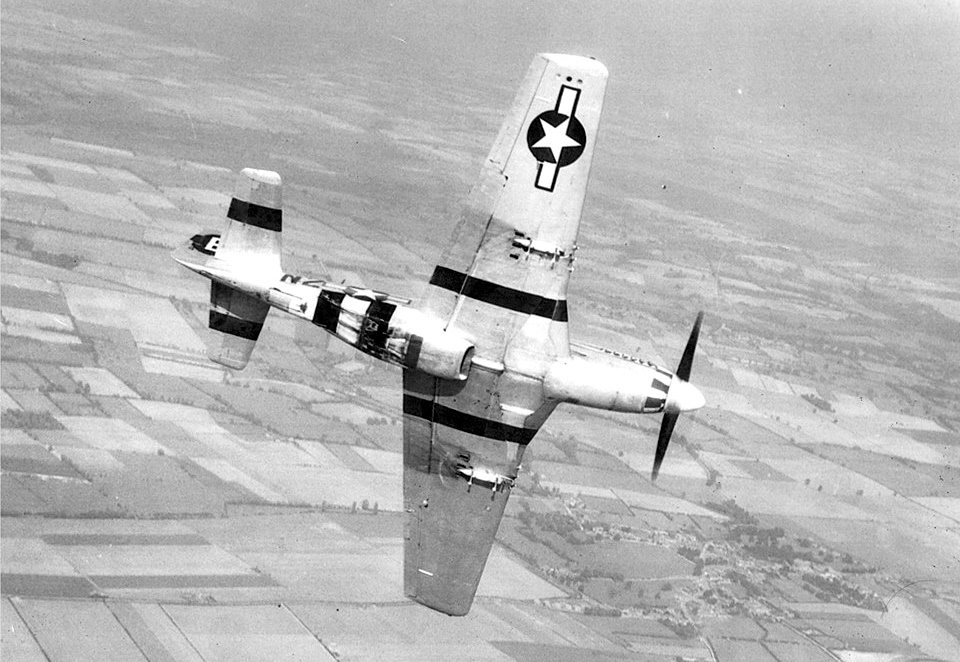 Group. It was soon in use also as a re-fueling and re-arming point for our fighter-bomber groups operating to the east.
Group. It was soon in use also as a re-fueling and re-arming point for our fighter-bomber groups operating to the east.
AUGUST 18-1944
It was harvest time in the Argentan-Trun Pocket, and Allied aircraft on this date had one of their biggest days of the war. Our P-47s of the 56th Group, on an early morning armed recon, reported 1000 to 1500 enemy vehicles headed north bumper to bumper in the Argentan–Trun area and later saw 1000 enemy vehicles of all types encircled by yellow smoke in the Falaise area. To their disappointment, our pilots were told not to attack because they were outside of their area. Most of the good targets were in the area of British responsibility, and the RAF’s 2nd TAC AF rolled up one of the biggest scores of the war against a concentration of some 7000 vehicles jamming the roads beyond the old Falaise gap, now only two miles wide.
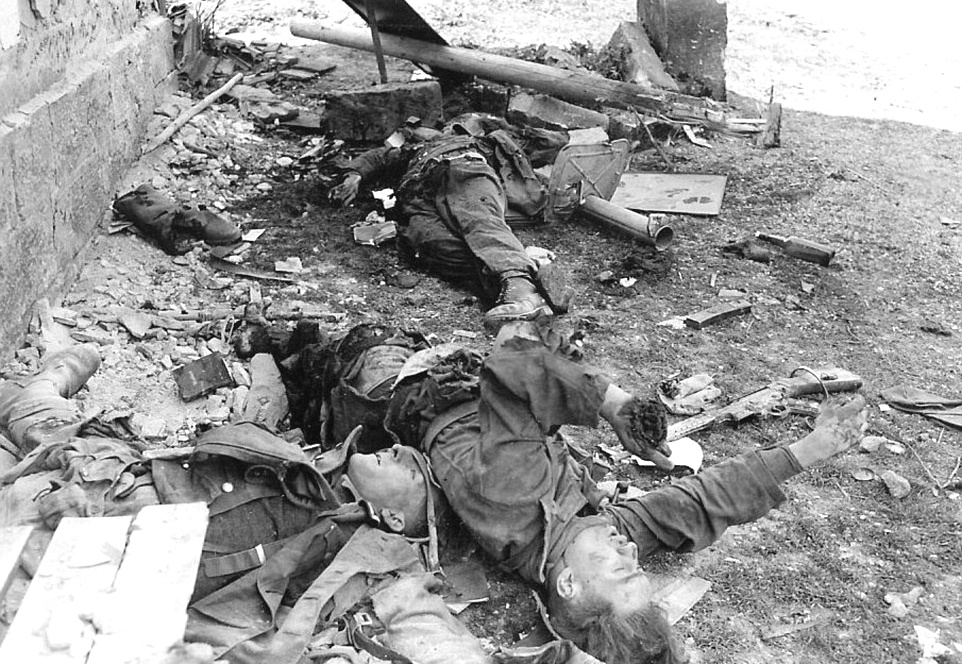 Attacking with rockets, bombs, cannon and machine guns, 2nd TAC-AF’s Spitfires, Typhoons and Mustangs claimed 1159 MT destroyed and 1724 damaged; 124 tanks destroyed and 96 damaged. Fifteen hundred sorties were flown and 25 aircraft were lost. One of Gen Montgomery’s staff officers announced that the power of resistance of the German 7. The army in Normandy had been smashed in a day of concentrated air attack. Although denied a chance at the big jackpot, our groups accounted for 17 tanks, 206 MT, 30 horse-drawn vehicles, 7 locomotives, and 218 railroad cars, 2 troop concentrations, a motor transport park, 5 gun positions, and 3 marshaling yards were attacked. Combat sorties totaled 679; claims were 5-0-2 (air) and losses 7.
Attacking with rockets, bombs, cannon and machine guns, 2nd TAC-AF’s Spitfires, Typhoons and Mustangs claimed 1159 MT destroyed and 1724 damaged; 124 tanks destroyed and 96 damaged. Fifteen hundred sorties were flown and 25 aircraft were lost. One of Gen Montgomery’s staff officers announced that the power of resistance of the German 7. The army in Normandy had been smashed in a day of concentrated air attack. Although denied a chance at the big jackpot, our groups accounted for 17 tanks, 206 MT, 30 horse-drawn vehicles, 7 locomotives, and 218 railroad cars, 2 troop concentrations, a motor transport park, 5 gun positions, and 3 marshaling yards were attacked. Combat sorties totaled 679; claims were 5-0-2 (air) and losses 7.
 During the day, swiftly advancing columns of XV Corps reached the Seine at Mantes–Gassicourt and at Vernon : where they controlled important crossings of the river and major road and rail routes into Paris from the west. With 3rd Army units now on the Seine, a new and much bigger pocket was already well in process of formation even before the first had been completely liquidated.
During the day, swiftly advancing columns of XV Corps reached the Seine at Mantes–Gassicourt and at Vernon : where they controlled important crossings of the river and major road and rail routes into Paris from the west. With 3rd Army units now on the Seine, a new and much bigger pocket was already well in process of formation even before the first had been completely liquidated.
All the German troops south of the Seine were endangered as XV Corps began moving eastward along the river and even established bridgeheads on the north bank. Other 3-A spearheads were ![]()
 reported in the Paris suburb of Versailles, in the vicinity of Milly south of Paris, and nearing Melun on the Seine 26 miles southeast of the capital. To complete the picture of disaster for the Germans, it was revealed that Allied forces that had landed in southern France were 30 miles inland at one point and were closing in on the naval base of Toulon. Still, a third pocket was now in the making, with US 7-A moving northward between the Rhone River and the Alps toward a junction with our 3-A.
reported in the Paris suburb of Versailles, in the vicinity of Milly south of Paris, and nearing Melun on the Seine 26 miles southeast of the capital. To complete the picture of disaster for the Germans, it was revealed that Allied forces that had landed in southern France were 30 miles inland at one point and were closing in on the naval base of Toulon. Still, a third pocket was now in the making, with US 7-A moving northward between the Rhone River and the Alps toward a junction with our 3-A.
AUGUST 19-1944
Our pilots flying over Paris on Aug 19 reported fires and explosions, indicating demolitions. Encirclement of the capital was now well underway. The 3-A patrols were 12 miles north of the Seine at a point 30 miles northwest of the capital, while south of the city the enemy was taking up positions on high ground in vain attempts to check Patton’s columns thrusting eastward. Air operations on this date were sharply curtailed by a cold front moving across our bases and target areas from west to east.
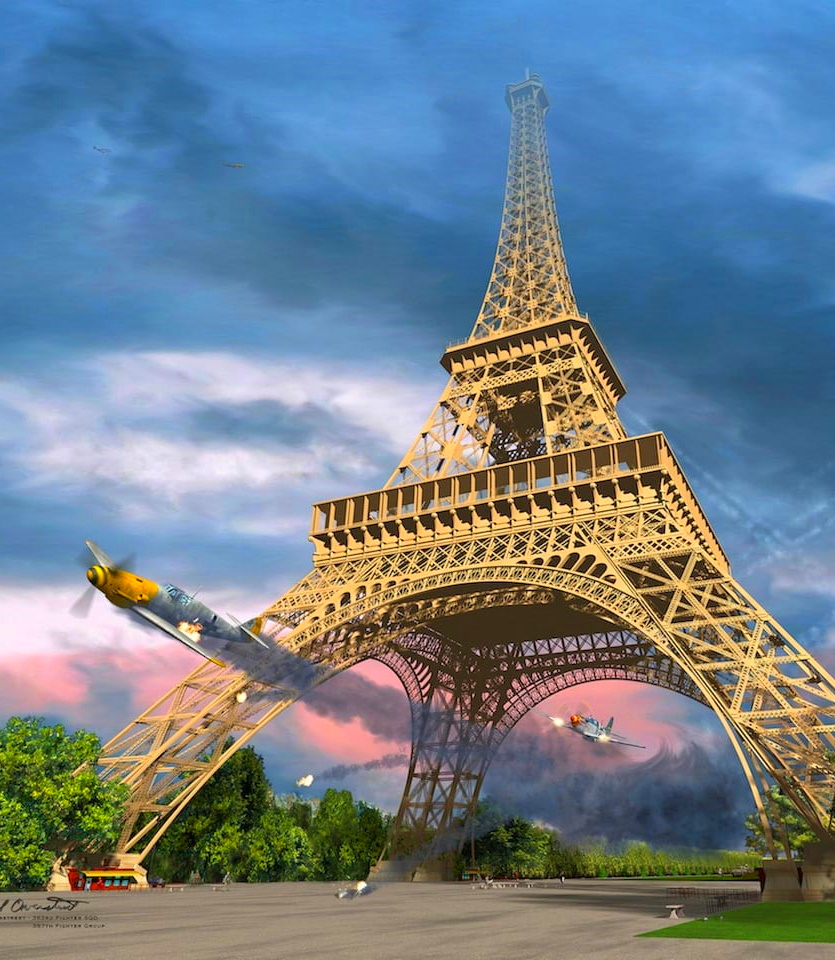 Several successful missions were flown in the morning, but the front closed down our bases in the afternoon, then moved into the target areas. Results included the destruction of 20 Seine River barges and damage to 91 more; other ground targets destroyed or damaged included 18 motor vehicles, an armored vehicle, 2 locomotives, 9 railroad cars, and 2 power launches. Two gun positions were attacked and a rail line cut.
Several successful missions were flown in the morning, but the front closed down our bases in the afternoon, then moved into the target areas. Results included the destruction of 20 Seine River barges and damage to 91 more; other ground targets destroyed or damaged included 18 motor vehicles, an armored vehicle, 2 locomotives, 9 railroad cars, and 2 power launches. Two gun positions were attacked and a rail line cut.
Combat sorties totaled 212 and recon sorties 34. Sharp aerial combat occurred, and 9 enemy aircraft were destroyed (8 of them in the air) against the loss of 5 planes and pilots. Flying close cover to armored units in the Dreux, Mantes, Gassicourt, Chartres, Etampes area, 8 P-47s of 571st Group chased away 18 enemy fighters apparently dive-bombing 5 miles east of Dreux and destroyed two for no loss. While strafing Fw-190s on the ground near Pontoise, the 406th Group’s 513th Sq was bounced by a number of enemy fighters. When the 512th Sq attempted to help, it in turn was bounced by 30 to 40 enemy aircraft at 8000 feet. The enemy kept some of his aircraft above the overcast, sending them down in twos and fours to take part in the fight. Final claims were 5-0-5 in air and destroyed on the ground for a loss of 5.
AUGUST 20-1944
Shortly before dark on Aug 20, pilots of the 406th Group reported the main highway from Paris to Sezanne loaded with dispersed enemy motor vehicles headed east. Marshaling yards at Joigny and Sezanne were likewise loaded. Obviously, the Germans were pulling out of Paris and confirmation came from many quarters, presaging the city’s fall. As the 3-A units drove ahead to secure the line of the Seine both above and below Paris, the Germans said rioting had broken out in the wrench capital and threatened to shoot anyone disobeying orders. US patrols were reported 10 miles from the center of the city.
West of Paris, too, the Germans were retreating, many crossing the virtually bridge-less Seine River during the night by pontoon, by ferry, and even by swimming. At the ferry slips our planes dropped delayed fused bombs set for detonation during the night, at the probable peak of the hurried, nocturnal exodus of supermen.
Rain and low ceilings limited combat sorties to 388 and recon, sorties to, 36. Road and rail transport provided the principal targets, and claims included 65 motor vehicles, 33 armored vehicles, 12 locomotives, and 150 railroad cars destroyed or damaged. Seven rail lines were cut and 2 marshaling yards, 3 ferry landings, and a machine-gun nest attacked. Claims in aerial combat were 6-0-1 and losses 3.

 Despite the weather, the 362nd Group had a busy day providing cover to the 7-AD and the 5-ID in the Dreux, Mantes, Gassicourt, Etampes, Chartres area. With frags, 500-GP, and strafing, they destroyed several tanks and attacked troops.
Despite the weather, the 362nd Group had a busy day providing cover to the 7-AD and the 5-ID in the Dreux, Mantes, Gassicourt, Etampes, Chartres area. With frags, 500-GP, and strafing, they destroyed several tanks and attacked troops.
Aircraft of this group also planted delay-fused bombs at ferry landings on the Seine and accounted for all of the day’s claims against enemy aircraft.

 All the losses were also suffered by the 362nd. Eight P-47s of the Group’s 378th Sq were bounced by 12 Me-109s and 20 Fw-190s at 5000 feet about 12 miles southwest of Paris at 1545. Despite the odds of 4 to 1, the Thunderbolts destroyed 6 and damaged 1 for the loss of 2 planes and 2 pilots.
All the losses were also suffered by the 362nd. Eight P-47s of the Group’s 378th Sq were bounced by 12 Me-109s and 20 Fw-190s at 5000 feet about 12 miles southwest of Paris at 1545. Despite the odds of 4 to 1, the Thunderbolts destroyed 6 and damaged 1 for the loss of 2 planes and 2 pilots.
A third P-47 was lost on a later mission. Covering the 5-AD and 79-ID in the Mantes, Gassicourt, and Seine River area, the 355th Group destroyed or damaged several tanks, shot up barges carrying enemy tanks across the Seine, chased away two Fw-190s and scored a direct bomb hit on a machine-gun nest marked by white smoke.
Armed recces by the 371st and the 406th Groups caused the enemy considerable havoc in crowded marshaling yards and along his road and rail communications to the east and south.












